The HTC 10 Review
by Joshua Ho on September 19, 2016 8:00 AM ESTBattery Life
Battery life is still one of the most important aspects of any mobile device, and as a result our testing of a mobile device needs to properly emphasize this aspect. As a result, it’s important that every device is tested in the same manner to avoid bias in one way or another. In order to achieve this, all devices have all possible background services disabled, as well as sync and automatic app updates. In order to try and make an even comparison we also set the display to 200 nits brightness on a 100% average picture level display, also known as a blank white screen. However, one area that we aren’t necessarily able to control for 100% of the time is ambient temperature, device orientation, or material contact. While tests that don’t reach TDP limits won’t see any effects, TDP-limited tests will see a delta here, but it’s hard to estimate just how much of an impact exists here. While we might be able to do some power characterization, in most cases review units are not allowed to be torn down and with a general decrease in the number of devices with removable batteries power characterization has to be done through the fuel gauge which is often unreliable. With the HTC 10, this fuel gauge is only updated every minute so there’s realistically no way to actually test power outside of full rundown tests.

In our first test we can see that the Galaxy S7 is actually slightly down on power efficiency relative to the HTC 10. I went back and ran the HTC 10 on our basically display-bound battery life test and the Galaxy S7 gets around 12.34 hours while the HTC 10 gets 11.63 hours. That’s about a 5-6% delta which is almost entirely down to display efficiency, so I suspect that the difference here is actually due to optimizations in DVFS and other optimizations that would probably fall under the “PowerBiotics” branding that HTC seems to be using here.
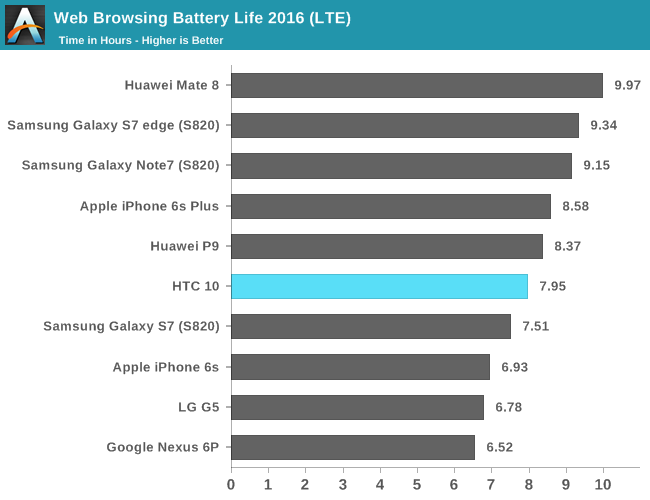
Moving on to the LTE version of this test we can see that HTC has really done an amazing job of implementing their cellular solution as battery life is basically identical to what it is on WiFi. It’s likely that poor reception conditions will tilt the scales back towards WiFi but in areas of good reception the HTC 10 has relatively good battery life on LTE. This is probably compounded by the fact that the HTC 10’s LTE reception is actually significantly above anything else I’ve used in recent memory including the LG G5 and Galaxy S7.
In the interest of trying to see whether this sort of pattern holds across the board, PCMark is another test that emphasizes power consumption but rather than just web browsing it attempts to have a mix of CPU and GPU usage in general purpose tasks as well as some general purpose IP blocks like video decode. While a relatively small part of overall power consumption, storage power consumption is also a part of the test as things like the photo editing subtest will involve reading and writing to non-volatile storage.
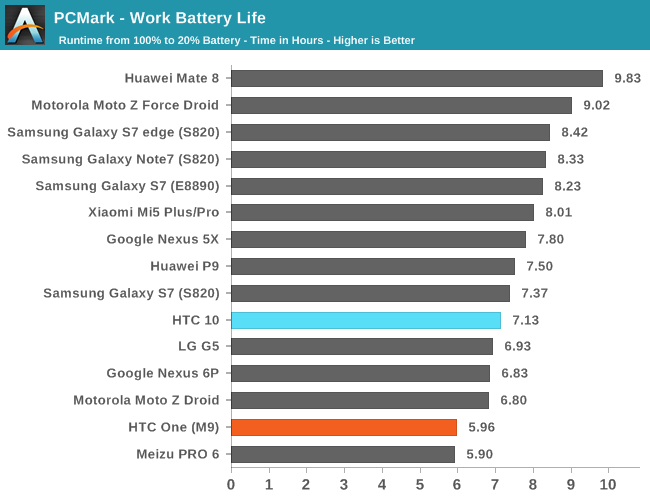
Interestingly enough, the HTC 10 ends up being slightly behind the Galaxy S7 here. Again, it’s likely that we’re looking at the difference in display power here as the Galaxy S7’s 1440p AMOLED display has a lower subpixel density and in a few tests the average picture level is relatively low. HTC is also using an ever so slightly larger display which would tilt the scales as well. Of course, none of this really changes the fact that display-bound workloads are going to see the HTC 10 performing worse than the Galaxy S7, but from an academic perspective it’s interesting to keep tabs on how AMOLED and LCD compare in terms of efficiency. It goes without saying that the Galaxy S7 edge with its huge battery easily pulls away from the HTC 10 and pretty much anything on the market but if you want a phone usable with one hand I would argue that the Galaxy S7 edge isn’t really a one-handed phone.
Moving on to the sustained rundown tests we can take a look at how an OEM has chosen to optimize their thermal management strategies, which often vary from device to device despite similar SoC and design. While we used to run Basemark OS II and GFXBench for this part of the test due to the arguably misleading results that Basemark OS II provides we’ve dropped it entirely to improve the signal to noise ratio of our reviews.
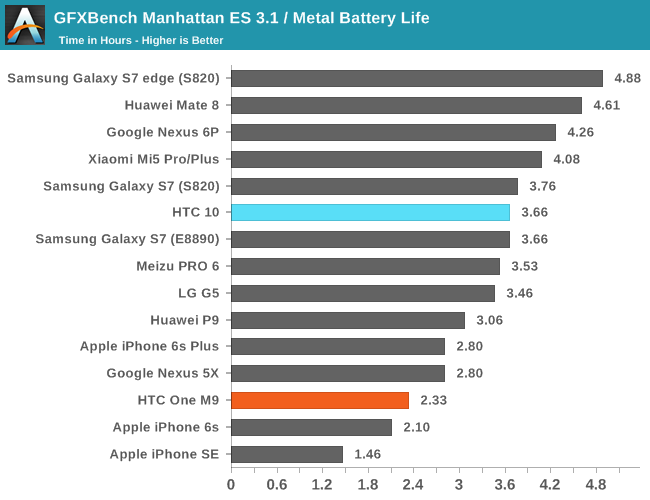
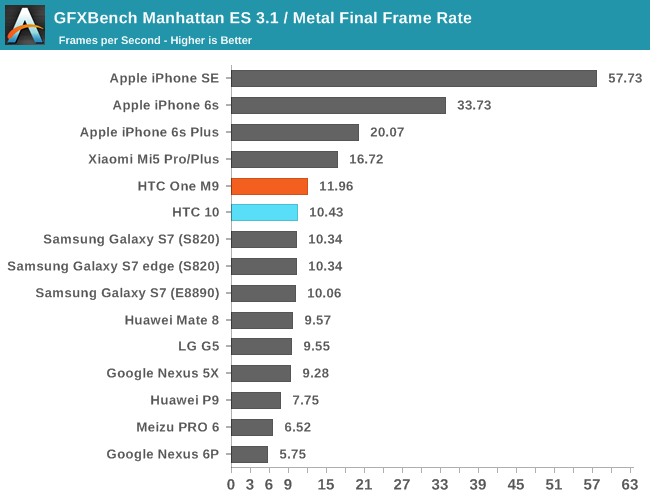
In GFXBench’s Manhattan ES 3.1 infinite rundown again we’re seeing the differences that come from display efficiency deltas but the difference is so small because SoC is pretty much the dominating factor when a display of this size will consume about a watt and the TDP-limited power consumption of the SoC is about two watts. What is noteworthy here is that HTC tends to do a better job of throttling the SoC such that the degradation is graceful. Samsung and LG both seem to favor maximizing short term performance which results in underdamped behavior which actually has a pretty appreciable impact on things like VR performance although given that no OEM is shipping Daydream-ready devices yet it isn’t necessarily critical for an OEM to be getting throttling right.
Overall, HTC does manages to pull in fairly respectable battery life despite being down on display efficiency. Our new tests manage to highlight the surprising level of optimization that HTC has put into the 10, but in use cases where you can’t really optimize things like cellular connectivity or governor behavior the HTC 10 slightly trails the Galaxy S7. When compared against something like the Galaxy S7 Exynos 8890 variants the HTC 10 is going to trail in anything CPU-bound as Kryo is just not as efficient as Exynos M1 for whatever reason. I don’t really think it’s a fair comparison but the Galaxy S7 edge is undoubtedly a big step up in battery life relative to the HTC 10, but this comparison only makes sense if you are willing to deal with the larger 5.5 inch display.
While I hate using screen-on time as a metric for battery life, generally speaking where the One M7 got about 3-4 hours of constant use when new the HTC 10 seems to achieve about 6 hours of use or so which is much more than what the 30% bump in battery capacity would suggest, especially once you factor in the half inch difference in display size, so the efficiency benefits of newer SoCs like the Snapdragon 820 are absolutely noticeable.
Charge Time
While battery life is probably the single most important metric of a mobile device, it’s important to not forget that these devices still need to spend at least some time wired up, whether directly in the form of an AC adapter or indirectly by swapping batteries. As a result it’s important to see how quickly the device’s battery will charge as generally speaking end users don’t hotswap batteries and charging the phone’s battery with an AC adapter is the dominant use case where charge time matters. To test this we use a number of methods, but for this review we will rely on measurements from the wall and using the time it takes for the device to drop to a certain level of power draw from the wall to indicate a full charge state, which is generally quite close to the time it takes for the device itself to indicate 100% but may take longer depending upon how an OEM adjusts battery state of charge determination and presentation.

It turns out that the HTC 10 charges fairly quickly, but it’s not necessarily as fast as what something with QC 2.0. This might seem counter-intuitive but realistically it’s not supposed to be faster than QC 2.0, but to reduce battery and device heating to better preserve the battery over time. Regardless, pretty much anything that charges in under 2 hours is going to be fairly comparable here. The Galaxy S7 does charge faster, but at the cost of overall battery lifetime. The LG G5 is actually slightly slower to charge here, so all things considered the HTC 10 is doing pretty well here. The one notable winner here is the OnePlus 3, which seems to charge quickly with relatively low battery heat due to its proprietary Dash Charge system.


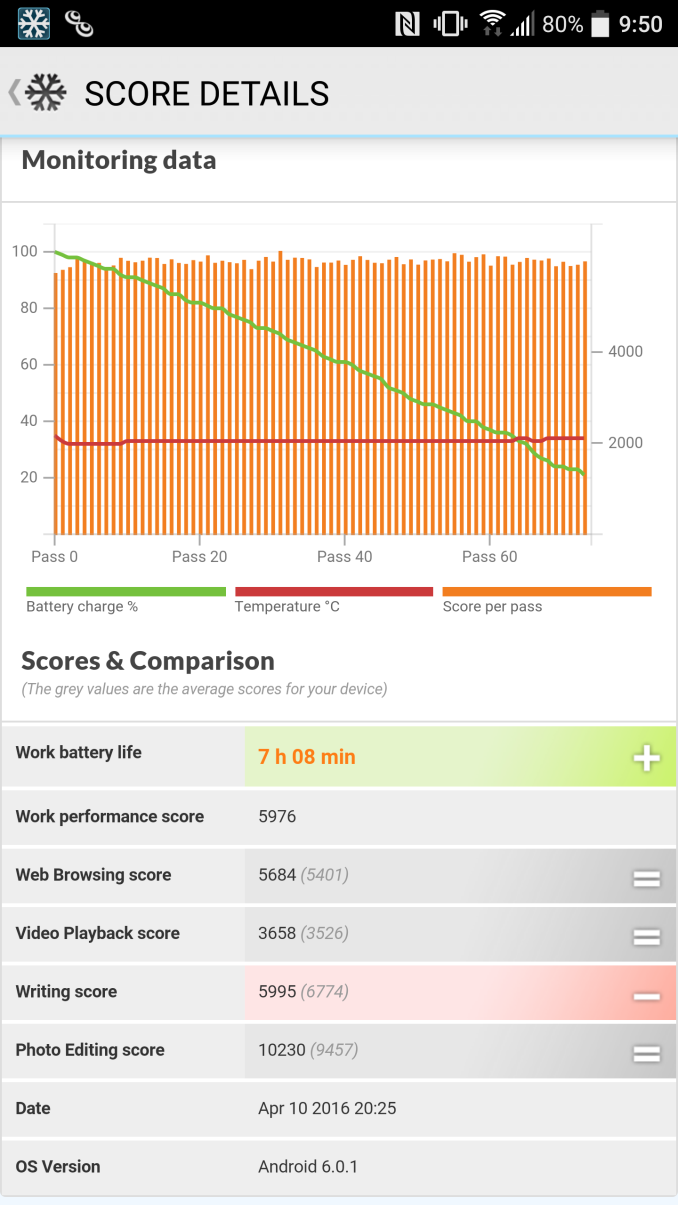
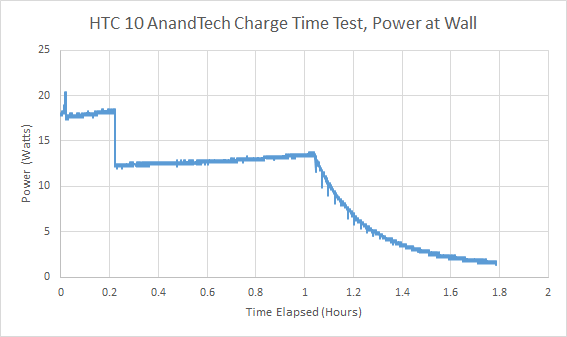








183 Comments
View All Comments
kmmatney - Monday, September 19, 2016 - link
Sounds like my experience a few years ago. I switched to a "high end" LG phone because I got tired of Apple not having larger screens. I loved it at first, but had a lot of the same issues - keyboard didn't work well, battery life sucked, and other annoying issues. Tried a few different ROMs (everyone seemed to have their favorites that was the "best" one), but that just made things worse - would fix a particular issue, but create several others. Stuck it out for 18 months, and then finally just sold it, took a $50 hit (hey, I'm cheap!), and bought a used iPhone 5 to tide me over for 6 months until next upgrade cycle. I guess it was all "user error" on my part.fanofanand - Tuesday, September 20, 2016 - link
You are absolutely right, expecting your SOT to match the "call time" numbers is totally normal. /sMorawka - Monday, September 19, 2016 - link
if this review is getting this many comments then HTC is doing something right here.StrangerGuy - Monday, September 19, 2016 - link
Yeah they doing a great job if market success is solely determined by how much comments the vocal tiny minority generates.Oh and BTW I'm sick of hearing trite being called "innovation" at every single corner. That buzzword is so debased to the point of uselessness.
JKJK - Monday, September 19, 2016 - link
Long time htc fan. Ordered one this weekend + a 200GB SD card.Good review, even thought it's a bit late. But finding bugs like wifi and such that MIGHT give it enought focus to make HTC look into it, is worth it. Even tought it has a few sore spots, I suppose it will be a nice upgrade from my M9 either way.
A friend of mine has one, and one thing I really don't like about it, is that is a bit unergonomic when you have small hands, like I do. And the edge on the back makes it uncomfortable to hold compared to the M9 because of this (edge).
JKJK - Monday, September 19, 2016 - link
Another weird thing ... It doesn't seem possible to find original norwegian / european charger for the HTC 10. I'm speaking of the Rapid charge / Quick Charge 3.0 with USB Type C. You actually have to buy another phone (!) at this point to get a charger. For now, I'm stuck with the M9's rapid charger / Quick charge 2.0 adapter and a belkin USB C cable. Very frustrating.It took almost a year before a Quick Charge 2.0 charger hit the market for the for the M9, and it hit england about 3 months before norway. According to Scandinavian (swedish) support, It's supposed to hit market "within 2016". Not good.
Vagabondjonez - Tuesday, September 20, 2016 - link
thats harsh man. I have so many qc 2 adapters lolfanofanand - Tuesday, September 20, 2016 - link
Google "Anker" they make fantastic QC 3.0 with Type C bases.JKJK - Tuesday, September 20, 2016 - link
Yes, but not with norwegian/european plugs?However. Found another qualcom certified qc3 chargers with europlug and usbc.
Compared with some high quality belkin cables with 3A suport and correct resistance, I think I'm gettig there.
I think it wad Aukey/Auky chargers
JKJK - Tuesday, September 20, 2016 - link
Err.. paired with the belkin cables.However. Original htc qc3 charger is said to be coming in sale this year (Htc tc p5000-eu/uk/etc.)